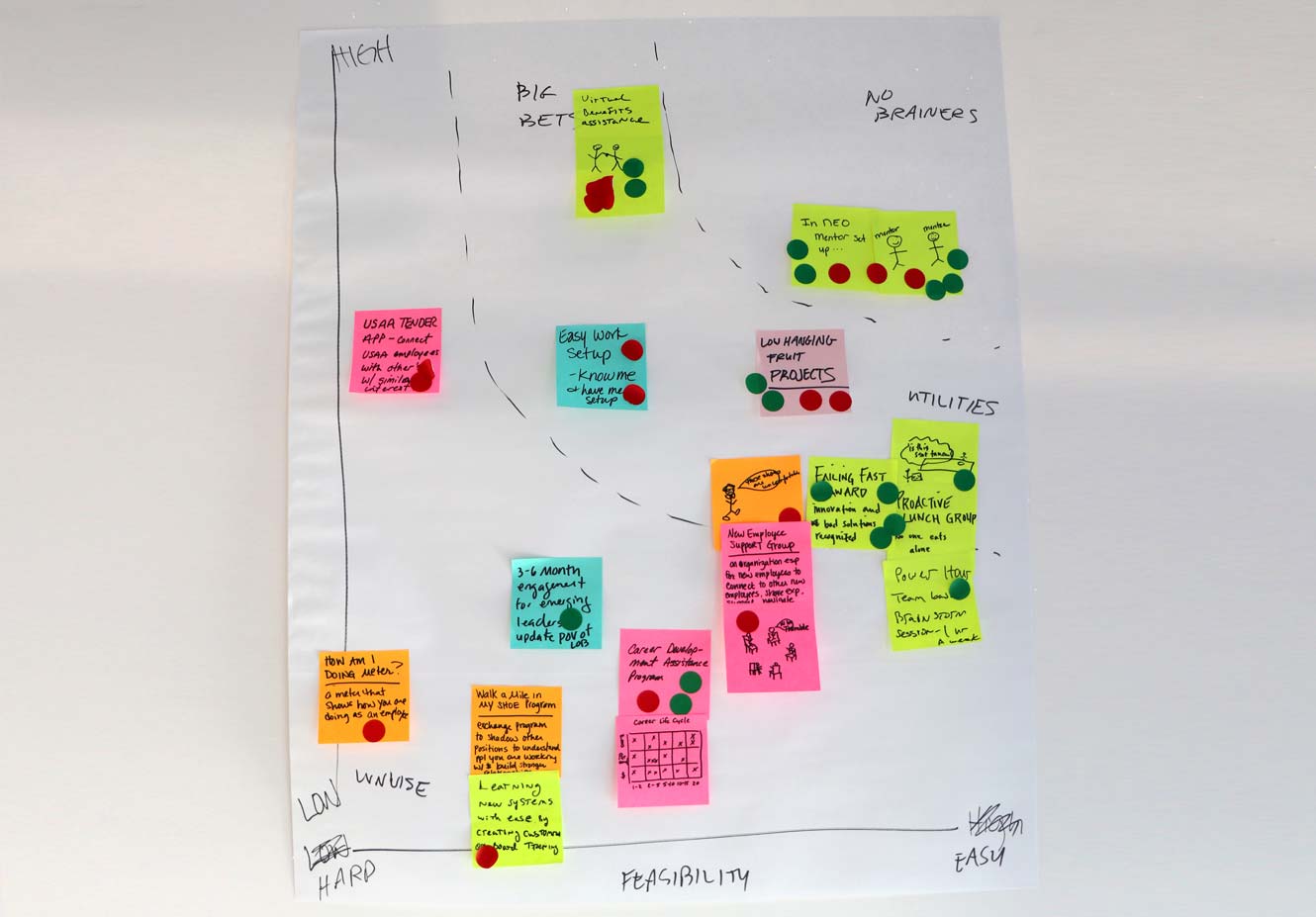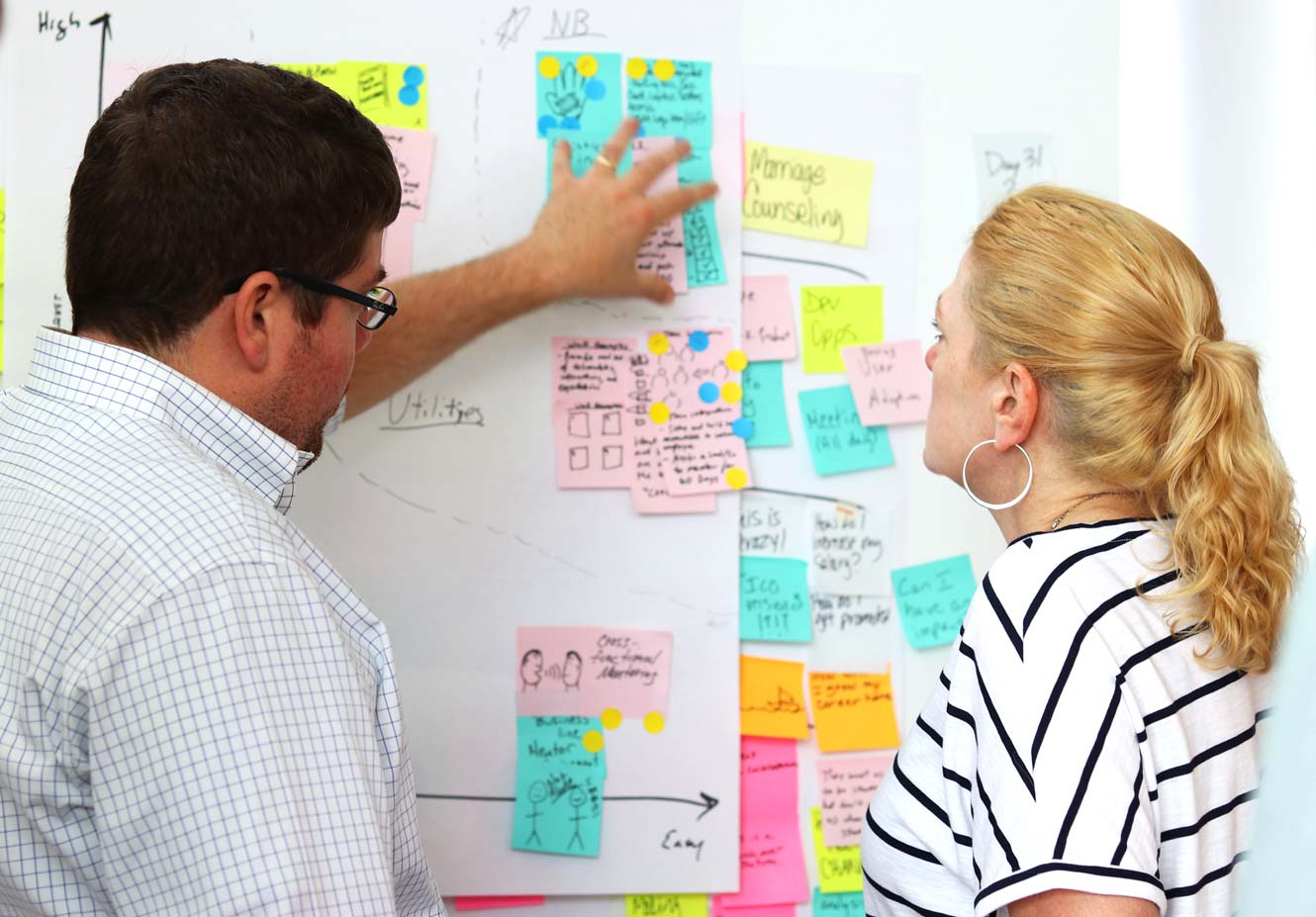Idea Prioritization
Idea Prioritization is a radical way to prioritize decisions based on objectivity, rather than focusing on one person's individual bias.
Idea Prioritization enables your teams to have a candid conversation about the value you can have on the member at the center of your experience. Team members individually vote for the impact and feasibility of an idea before building a consensus, so the entire team can leverage the collective brainpower of the group to make an informed decision.
You can use Idea Prioritization to:
- Prioritize your ideas based on impact (human and market) and feasibility (ease of implementation).
- Decide which ideas make the most sense for the team to focus on.
- Create alignment on a prioritized backlog of ideas and work the team would like to accomplish.
Prerequisites
A team can use Idea Prioritization once they have:
- Generated a list of ideas, potential solutions, or completed the Idea Vignettes and/or Wild Cards method.
- Reviewed business and member data to inform the potential impact of the future work.
- Determined a general timeline to inform the feasibility scale your team will use during voting.
- Put all the ideas up and group very similar or redundant ideas together.
This Is What It Looks Like



Template Downloads
Let’s Get Started
1 Draw a prioritization grid.
Draw an X and Y axis on a white board or large piece of chart paper (flush with the left and bottom edge of the sheet). Label the X axis "Feasibility" and the Y axis "Impact."
! Dot voting.
Before your team can plot ideas on the grid, they need to dot vote. Dot Voting is a quick method gives all participants equal influence in determining which ideas the team will tackle. Participants vote on a large pool of ideas, but have a small number of votes. Dot Voting forces teams to pick the best ideas. The leftovers are moved to an "idea backlog" for future voting and prioritization.
2 Vote on impact.
Ask the team to take the blue dot stickers and place one (or more) on the ideas they think will have the highest IMPACT to the market or to the member experience.
Watch Out
Some ideas might have 2-3 ideas within them. Try to break large, thorny vignettes into single ideas. Conversely, some ideas are very similar or redundant. Group them together so that the team doesn't split votes between two ideas that are essentially the same.
3 Vote on feasibility.
Ask the team to take the yellow dot stickers and place one (or more) on the ideas with the greatest FEASIBILITY, or which ideas will be the easiest to implement. Feasibility can be determined by project timeline, available resources, staffing or level of effort, or budget. This will vary from project to project.
Watch Out
Do your best to ignore the IMPACT votes while voting for feasibility. Perceived impact shouldn't influence the feasibility of each idea.
4 Plot ideas vertically based on impact.
Move Idea Vignettes with blue impact dots on to the Idea Prioritization Grid. Higher impact ideas are higher up on the Y-axis, lower impact ideas are closer to the bottom of the grid. Discuss the results with your group as you plot the ideas. You can still change your mind: the number of dots are a guide not an mandate. The goal is to encourage conversation and alignment.
5 Plot ideas horizontally based on feasibility.
Move any remaining Idea Vignettes with yellow feasibility dots onto the grid. Highly feasible ideas are further to the right on the X-axis, while difficult ideas are closer to the left. Move the ideas you plotted during the Impact step along the X-axis based on any feasibility votes. Focus on the yellow (feasible) dots and discuss the ease of implementation as it relates to time, resources, effort, or budget. Again, the team can overrule the dot votes as long as they discuss the changes and are aligned.
6 Synthesize: Prioritize ideas.
Now that the ideas are plotted on both the X- and Y-axis, you can start to see emerging trends or groups. Draw two descending curves on the grid (see photo below) and label the new sections Unwise, Utilities, Big Bets and No Brainers. If an idea falls on a border or feels incorrectly categorized, discuss and align as a team on where it should be placed.
- Unwise: Ideas with low impact and low feasibility. Pursuing these ideas would likely be unsuccessful.
- Utilities: Ideas that are medium to low impact with medium to high feasibility. Utilities feel safe because they are easier to scope and execute but are simultaneously risky because they are unlikely to lead to advantages or impact.
- Big Bets: Ideas with high impact, and medium-to-low feasibility. These ideas can be market differentiators and are often worth pursuing balanced against team constraints.
- No Brainers: Is the Why a benefit to the target member? Would she say “Wow! Thank you!” if we read her this statement?
Watch Out
Competitors will also be focused on No-Brainers, so they may end up being table stakes. Challenge your team to make Utilities more impactful and Big Bets more feasible.
Next Steps
Determine which ideas your team will pursue in the short-term, balanced against team KPIs, marketing strategy and any No-Brainers your experience needs to stay competitive. Translate these priorities into the appropriate backlogs.